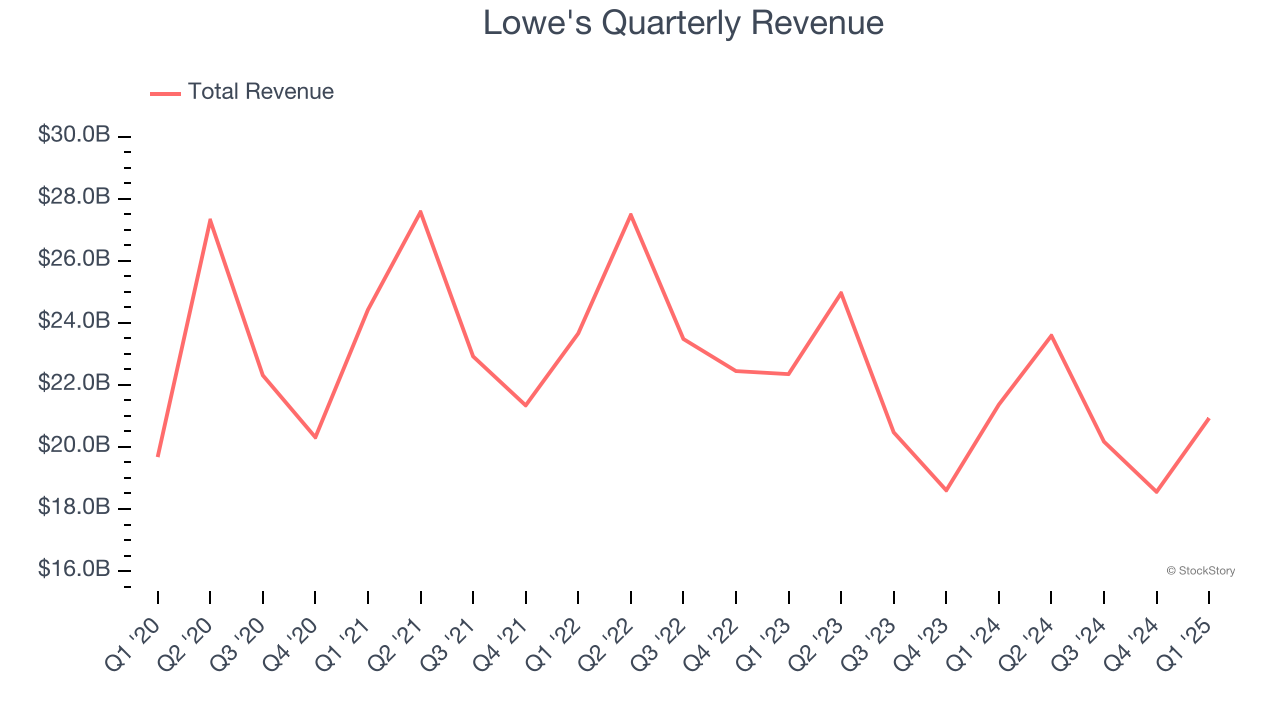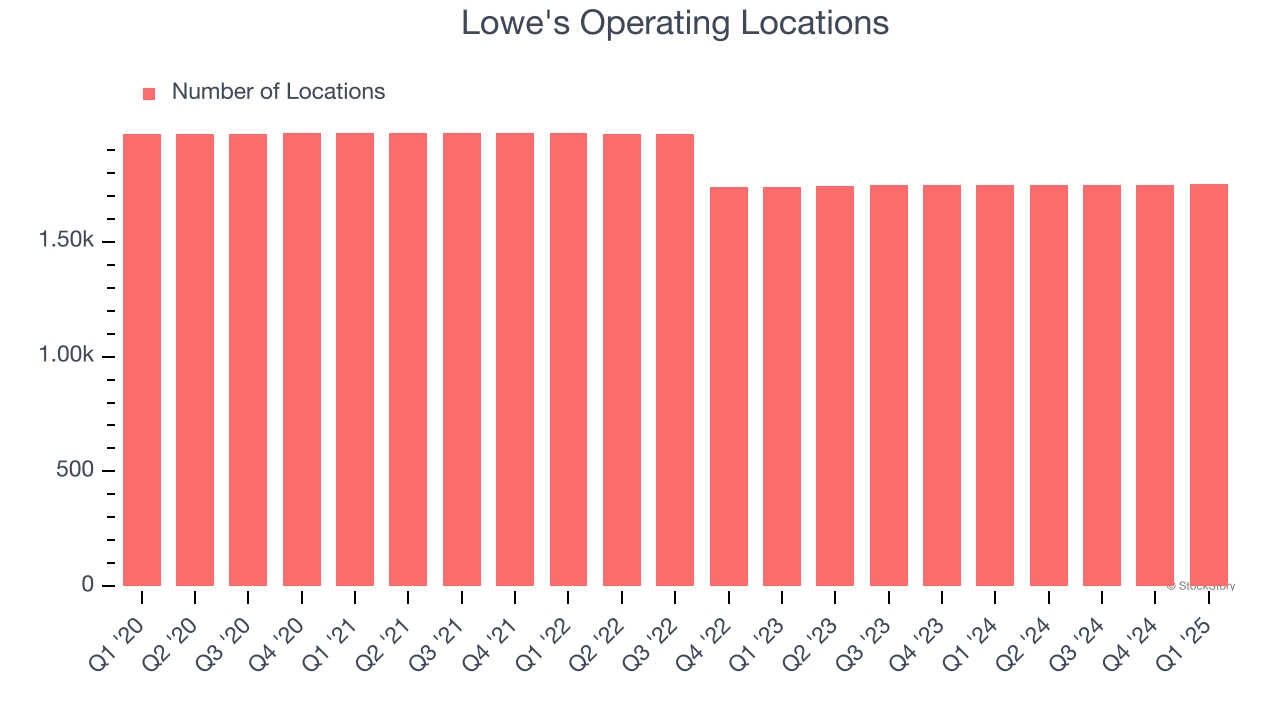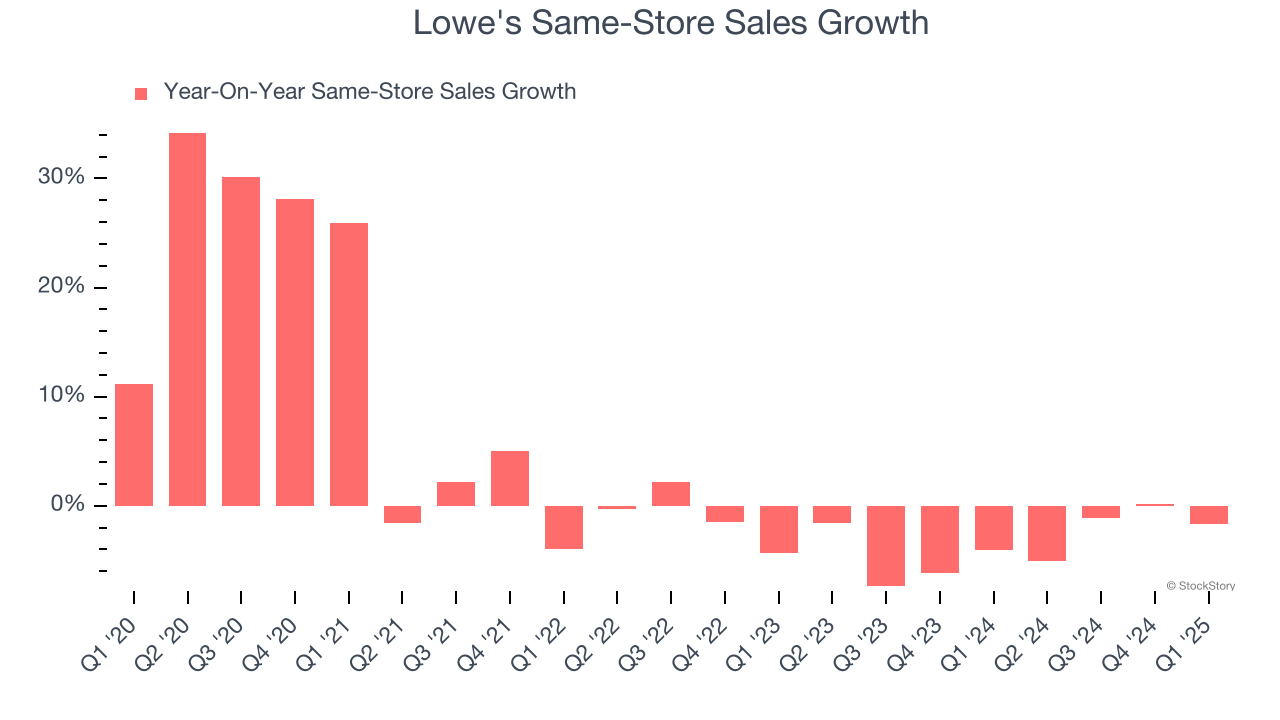
Home improvement retailer Lowe’s (NYSE:LOW) met Wall Street’s revenue expectations in Q1 CY2025, but sales fell by 2% year on year to $20.93 billion. The company’s outlook for the full year was close to analysts’ estimates with revenue guided to $84 billion at the midpoint. Its GAAP profit of $2.92 per share was 1.7% above analysts’ consensus estimates.
Is now the time to buy Lowe's? Find out by accessing our full research report, it’s free.
Lowe's (LOW) Q1 CY2025 Highlights:
- Revenue: $20.93 billion vs analyst estimates of $20.93 billion (2% year-on-year decline, in line)
- EPS (GAAP): $2.92 vs analyst estimates of $2.87 (1.7% beat)
- The company reconfirmed its revenue guidance for the full year of $84 billion at the midpoint
- EPS (GAAP) guidance for the full year is $12.28 at the midpoint, roughly in line with what analysts were expecting
- Operating Margin: 11.9%, in line with the same quarter last year
- Free Cash Flow Margin: 13.7%, down from 18.2% in the same quarter last year
- Locations: 1,750 at quarter end, up from 1,746 in the same quarter last year
- Same-Store Sales fell 1.7% year on year (-4.1% in the same quarter last year)
- Market Capitalization: $129.4 billion
"Despite near-term uncertainty and housing market headwinds, our team's unwavering focus on exceptional customer service has elevated satisfaction scores and earned Lowe's the #1 ranking in Customer Satisfaction among Home Improvement Retailers* by J.D. Power," said Marvin R. Ellison, Lowe's chairman, president and CEO.
Company Overview
Founded in North Carolina as Lowe's North Wilkesboro Hardware, the company is a home improvement retailer that sells everything from paint to tools to building materials.
Sales Growth
A company’s long-term sales performance can indicate its overall quality. Any business can have short-term success, but a top-tier one grows for years.
With $83.24 billion in revenue over the past 12 months, Lowe's is a behemoth in the consumer retail sector and benefits from economies of scale, giving it an edge in distribution. This also enables it to gain more leverage on its fixed costs than smaller competitors and the flexibility to offer lower prices. However, its scale is a double-edged sword because there are only a finite number of places to build new stores, making it harder to find incremental growth. To accelerate sales, Lowe's likely needs to optimize its pricing or lean into international expansion.
As you can see below, Lowe’s sales grew at a sluggish 2.5% compounded annual growth rate over the last six years (we compare to 2019 to normalize for COVID-19 impacts) as it closed stores.

This quarter, Lowe's reported a rather uninspiring 2% year-on-year revenue decline to $20.93 billion of revenue, in line with Wall Street’s estimates.
Looking ahead, sell-side analysts expect revenue to grow 2.2% over the next 12 months, similar to its six-year rate. This projection doesn't excite us and suggests its newer products will not catalyze better top-line performance yet.
Today’s young investors won’t have read the timeless lessons in Gorilla Game: Picking Winners In High Technology because it was written more than 20 years ago when Microsoft and Apple were first establishing their supremacy. But if we apply the same principles, then enterprise software stocks leveraging their own generative AI capabilities may well be the Gorillas of the future. So, in that spirit, we are excited to present our Special Free Report on a profitable, fast-growing enterprise software stock that is already riding the automation wave and looking to catch the generative AI next.
Store Performance
Number of Stores
The number of stores a retailer operates is a critical driver of how quickly company-level sales can grow.
Lowe's listed 1,750 locations in the latest quarter and has generally closed its stores over the last two years, averaging 2.7% annual declines.
When a retailer shutters stores, it usually means that brick-and-mortar demand is less than supply, and it is responding by closing underperforming locations to improve profitability.

Same-Store Sales
A company's store base only paints one part of the picture. When demand is high, it makes sense to open more. But when demand is low, it’s prudent to close some locations and use the money in other ways. Same-store sales is an industry measure of whether revenue is growing at those existing stores and is driven by customer visits (often called traffic) and the average spending per customer (ticket).
Lowe’s demand has been shrinking over the last two years as its same-store sales have averaged 3.4% annual declines. This performance isn’t ideal, and Lowe's is attempting to boost same-store sales by closing stores (fewer locations sometimes lead to higher same-store sales).

In the latest quarter, Lowe’s same-store sales fell by 1.7% year on year. This decrease represents a further deceleration from its historical levels. We hope the business can get back on track.
Key Takeaways from Lowe’s Q1 Results
It was encouraging to see Lowe's beat analysts’ EPS expectations this quarter, even though the magnitude was not large. We were also comforted that the company reaffirmed previously-provided revenue guidance. Zooming out, we think this was a decent quarter, especially considering uncertainty in the macro and with regards to consumer health. The stock traded up 2.6% to $237 immediately following the results.
Is Lowe's an attractive investment opportunity right now? If you’re making that decision, you should consider the bigger picture of valuation, business qualities, as well as the latest earnings. We cover that in our actionable full research report which you can read here, it’s free.
